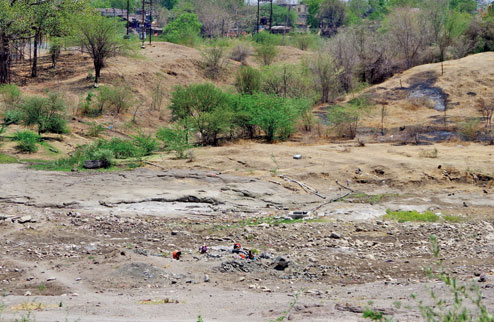In the winter of 2016, during a return journey from the interior villages of Parbhani district one full moon night, the driver of our vehicle asked whether we would like to take a short cut. “You will also get a close view of the Godavari river,” he prodded. Hungry, tired, and eager to reach our destination as soon as possible, we agreed to the driver’s request, little knowing that our drive wasn’t over the Godavari river, but right through it instead.
The river bed, appeared dry and caked, the bright moonlight dancing brightly off it, giving off an eerie feeling. As we drove on for a full 30 minutes through the river bed, it took us a full moment to realise that the legendary Godavari river, one of the longest rivers in the country, had almost vanished in Parbhani, and all that remained of her was the hard and dusty land below us.
The river that has disappeared
Often referred to as Dakshin Ganga (South Ganga), the Godavari river originates at Trimbakeshwar Hill in Nashik district of Maharashtra, and extends to the states of Telangana, Madhya Pradesh, Andhra Pradesh, Chhattisgarh, Odisha and Karnataka. After flowing for over 1,465 kilometres it finally falls off towards the east into the Bay of Bengal. Although the Godavari has many dams and barrages over it spread across the state, the river has dried up in the districts of Beed, Hingoli, Nanded, Latur and Parbhani through which it flows. Godavari which supplies water for drinking as well as for several agricultural purposes, (it even supports wildlife in several sanctuaries that it flows through), has been and continues to be embroiled in disputes across the states that it flows. The careers of many politicians have flourished thanks to this river.
Like the Godavari, the Narmada river too has been dominating headlines for decades now. The waters of this largest river too had invited protests and agitations due to the controversial Sardar Sarovar Dam project.
Activists who have been advocating for the rights of such river waters point out that the politics over making the waters of these rivers accessible to the common man has been happening for decades now, but they may cease to exist once big corporations and industries come into the picture. Many believe that under the guise of development, industries seeking access for water through governmental subsidies may soon end up dominating this natural resource, thereby cutting off everyone from it.
Many settlements of villages along the riverbanks of these rivers, which had free access to the waters of these rivers, are forced to move out and are displaced overnight. The original inhabitants of these lands — farmers, the nomadic tribes, forest dwellers, soon find themselves orphaned due to such ‘redevelopment policies’.
Dam it all
Activist Sanjay Kale informs that dams were originally constructed keeping the needs of the common man and agriculture in mind. But today, water has become a commodity thanks to the corporations who claim to own it. He has been advocating for making the waters of the Godavari accessible to the common man for drinking and agricultural purposes.
“In the priority list as per the National Water Policy, water should first be allotted for drinking, then agriculture, and lastly for industry purposes. But in the year 2005, the Maharashtra Water Policy was changed, and water was awarded to industry on second priority, replacing agriculture. The then ruling government allocated and reserved maximum water for industry between 2005 – 2011. It was only in 2011, after I raised this issue that the policy was reverted, but the reservations were not revoked,” he says.
Kale continues that agriculture which is dependent on dams has been threatened as the priority has changed only on papers. “The Act still holds agriculture as tertiary. The government has sanctioned lifting irrigation on dams, huge illegal water lifts have thereby created a big threat to water management,” he states, adding that reservation of water meant for agriculture is being diverted to industries and development of cities had further endangered the future of its availability. By 2041, water for agriculture may almost be non-accessible.
It is a known fact that industries need a lot of water to function, and tapping into government controlled dams and reservoirs seem to be an easy way. Kale points out that Aurangabad for example has the highest number of liquor industries, and it requires 25 litres of water to produce every litre of liquor. Often, governments have no record regarding water storage capacity of the companies, nor have they ever checked water lifting by industries.
Author and economist Robin Banerjee warns that water is currently the scarcest commodity on earth. “Strange as it may seem that with over three-fourth of the earth’s surface covered with water, there is not enough potable water. I feel that if there is another world war in the near future, the cause of it could be water. With enhanced paucity, many commercial organisations are looking at ‘water’ as a business opportunity. There is nothing wrong with it, as long as the poor are not taken for a ride or deprived of it.” He opines that governments must focus on rain water harvesting, water conservation, and economical conversion of salt-water into potable stuff.
“Till this is done, water could become a serious tradable commodity with many not being able to afford it”, he concludes.


 [/column]
[/column]